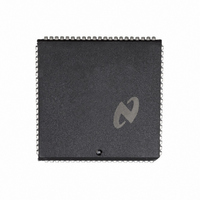DP8344BV National Semiconductor, DP8344BV Datasheet - Page 53

DP8344BV
Manufacturer Part Number
DP8344BV
Description
IC BIPHASE COMM PROCESSR 84-PLCC
Manufacturer
National Semiconductor
Datasheet
1.DP8344BV.pdf
(184 pages)
Specifications of DP8344BV
Processor Type
8-Bit RISC
Speed
20MHz
Voltage
4.5 ~ 5.5V
Mounting Type
Surface Mount
Package / Case
84-PLCC
Operating Supply Voltage (typ)
5V
Operating Supply Voltage (max)
5.5V
Operating Supply Voltage (min)
4.5V
Mounting
Surface Mount
Operating Temperature (max)
70C
Operating Temperature (min)
0C
Operating Temperature Classification
Commercial
Lead Free Status / RoHS Status
Contains lead / RoHS non-compliant
Features
-
Lead Free Status / Rohs Status
Not Compliant
Other names
*DP8344BV
Available stocks
Company
Part Number
Manufacturer
Quantity
Price
Company:
Part Number:
DP8344BV
Manufacturer:
NSC
Quantity:
5 510
Part Number:
DP8344BV
Manufacturer:
NS/国半
Quantity:
20 000
3 0 Transceiver
3 2 2 Receiver
The receiver accepts a serial biphase-encoded bit stream
strips off the framing information checks for errors and re-
formats the data for parallel transfer to the CPU The block
diagram in Figure 3-6 depicts the data flow from the serial
input(s) to the FIFO’s parallel outputs Note that the FIFO
outputs are multiplexed with the Error Code Register ECR
outputs
The receiver and transmitter share the same TCLK though
in the receiver this clock is used only to establish the sam-
pling rate for the incoming biphase encoded data All control
timing is derived from a clock signal extracted from this
data Several status flags and interrupts are made available
to the CPU to handle the asynchronous nature of the incom-
ing data stream See Figure 3-8 for the timing relationships
of these flags and interrupts relative to the incoming data
The input source to the decoder can be either the on-chip
analog line receiver the DATA-IN input or the output of the
transmitter (for on-chip loopback operation) Two bits the
Select Line Receiver SLR and Loopback LOOP control
this selection For interfacing to the on-chip analog line re-
ceiver see Section 3 2 5 1 3270 Line Interface An example
of an external comparator circuit for interfacing to twinax
cable in 5250 environments is contained in Section 3 2 5 2
5250 Line Interface The selected serial data input can be
inverted via the Receiver Invert RIN control bit
The receiver continually monitors the line sampling at a fre-
quency equal to eight times the expected data rate The
Line Active flag LA is asserted whenever an input tran-
sition is detected and will remain asserted as long as anoth-
er input transition is detected within 16 TCLK cycles If an-
other transition is not detected in this time frame LA will
be de-asserted The propagation delay from the occurrence
of the edge to LA being set is approximately 1 transceiver
clock cycle This function is independent of the mode of
operation of the transceiver LA will continue to respond to
input signal transitions even if the transmitter is activated
and the receiver disabled
(Continued)
FIGURE 3-7 Transmitter Output
53
If the receiver is not disabled by the transmitter or by assert-
ing TRES the decoder will adjust its internal timing to the
incoming transitions attempting to synchronize to valid bi-
phase-encoded data When synchronization occurs the bi-
phase clock will be extracted and the serial NRZ (Non-Re-
turn to Zero) data will be analyzed for a valid start se-
quence see Figure 3-2(b) The minimum number of line
quiesce bits required by the receiver logic is selectable via
the Receiver Line Quiesce RLQ control bit If this bit is set
high (the power-up condition) three line quiesce bits are
required if set low only two are needed Once the start
sequence has been recognized the receiver asserts the
Receiver Active flag RA and enables the error detection
circuitry The propagation delay from the occurrence of the
mid-bit edge of the sync bit in the starting sequence to RA
being set is approximately 3 transceiver clock cycles
The NRZ serial bit stream is now clocked into a serial to
parallel shift register and analyzed according to the expect-
ed data pattern as defined by the protocol If no errors are
detected by the word parity bit the parallel data (up to a
total of 11-bits depending on the protocol) is passed to the
first location of the FIFO It then propagates asynchronously
to the last location in approximately 40 ns at which time the
Data Available flag DAV is asserted indicating to the CPU
that valid data is available in the FIFO The propagation
delay from the occurrence of the mid-bit edge of the parity
bit of the frame to DAV being set is approximately 5 trans-
ceiver clock cycles
Of the possible 11-bits in the last location of the FIFO 8-bits
(data byte) are mapped into RTR and the remaining bits
(if any) are mapped into the Transceiver Status Register
reading TSR
note that TSR must be read before RTR
nized as set by the CPU the data can be read by any in-
struction with RTR as the source All instructions with
TSR 2– 0
RTR
RTR advances the FIFO Once DAV has been recog-
RTR as the source (except BIT CMP JRMK JMP reg-
and the 5250 address field or 3270 control bits by
The CPU accesses the data byte by reading
When reading the FIFO it is important to
TL F 9336– 45
since reading












